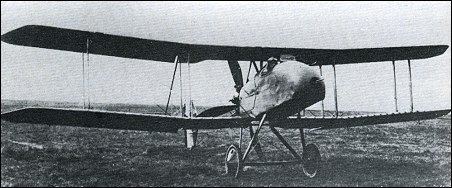|
| Designed under the direction of John Kenworthy, the
F.E.8 was the first single-seat fighter evolved as such at
Farnborough, where the first of two prototypes was
flown on 15 October 1915. Of pusher configuration to
allow an uninterrupted forward field of fire for the
7.7mm Lewis gun, the F.E.8 was a two-bay
equi-span biplane with a short fuselage nacelle to
accommodate the gun, the pilot and a 100hp Gnome
Monosoupape nine-cylinder rotary engine, and four
slender booms to carry the cruciform tail unit. Construction
of the nacelle was of welded steel-tube with
aluminium sheet covering; the wings and tail unit used
conventional wooden spars and ribs with fabric covering.
Trials with the second prototype in France in late
1915 led to a change in the gun installation, which was
mounted within the nacelle nose and could be moved
through a limited range by means of a control in the
cockpit. Production F.E.8s, which began to appear in
May and June 1916 from the factories of Darracq Motor
Engineering at Fulham and Vickers at Weybridge, had
a more practical gun mounting on the nose immediately ahead of the cockpit. Production totalled 220 by Darracq
and 50 by Vickers. Service use by RFC squadrons
in France began in August 1916, and, although soon
obsolescent, the F.E.8 remained in service for a year,
becoming the last single-seater of pusher configuration
in general use. Trial installations of the 110hp Le Rhone
and 110hp Clerget engines were made, but the Monosoupape
remained the standard fit.
 | A three-view drawing (1280 x 860) |
| WEIGHTS |
| Take-off weight | 611 kg | 1347 lb |
| Empty weight | 406 kg | 895 lb |
| DIMENSIONS |
| Wingspan | 9.60 m | 32 ft 6 in |
| Length | 7.21 m | 24 ft 8 in |
| Height | 2.79 m | 9 ft 2 in |
| Wing area | 20.25 m2 | 217.97 sq ft |
| PERFORMANCE |
| Max. speed | 151 km/h | 94 mph |
| Ceiling | 4636 m | 15200 ft |
| Arthur Davies, e-mail, 14.07.2015 07:14 These planes are so great I just love the first world war planes,so happy to see people rebuilding these majestic planes,so they won't be forgotten well done. reply | | Klaatu83, e-mail, 18.01.2015 17:56 The F.E.8 was designed as a single-seat fighter at a time before any practical means was available in Britain to synchronize a machine gun to fire through a propeller without hitting the blades. It's performance was considered to be not quite as good as it's contemporary, the Airco DH-2. However, in the end both aircraft were rendered obsolete by the introduction of superior German fighters with synchronized forward-firing machine guns. reply | | John Potts, e-mail, 14.07.2013 00:10 I found it very interesting, was clearing my dads old garage and found a propeller in the corner with all the markings of F.E.aircraft reply | | pree, 20.06.2011 13:55 I would like to see a more detailed view of control cable runs to the tailplane but apart from that it is a good drawing. reply | |
| | ?????????????, e-mail, 15.09.2009 16:42 this isnt what i wanted!!! S**T reply | | ?????, e-mail, 15.09.2009 16:41 ???? reply | | Craig Bland, e-mail, 28.05.2009 00:46 I have enjoyed the site and description of the plane, I visited your site as a matter of research as I am a French Polisher and am currently restoring and polishing a propellor off of one of these planes, thanks for the info. reply | | adrian smith, e-mail, 16.11.2008 15:02 I would like to see a more detailed view of control cable runs to the tailplane but apart from that it is a good drawing. reply | | Mark, e-mail, 17.02.2008 03:17 Enjoy your site, but just in case you did not know your plane pages are being mirrored or duplicated page per page through the following link at avia.russian.ee /air /england /raf_fe-8.php reply |
|
Do you have any comments?
|
| 
COMPANY
PROFILE
All the World's Rotorcraft
|







